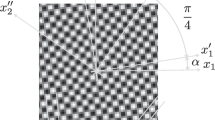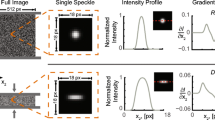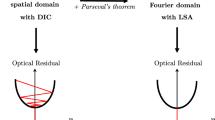Abstract
Digital Image Correlation (DIC) and Localized Spectrum Analysis (LSA) are two techniques available to extract displacement fields from images of deformed surfaces marked with contrasted patterns. Both techniques consist in minimizing the optical residual. DIC performs this minimization iteratively in the real domain on random patterns such as speckles. LSA performs this minimization nearly straightforwardly in the Fourier domain on periodic patterns such as grids or checkerboards. The particular case of local DIC performed pixelwise is considered here. In this case and regardless of noise, local DIC and LSA both provide displacement fields equal to the actual one convolved by a kernel known a priori. The kernel corresponds indeed to the Savitzky-Golay filter in local DIC, and to the analysis window of the windowed Fourier transform used in LSA. Convolution reduces the noise level, but it also causes actual details in displacement and strain maps to be returned with a damped amplitude, thus with a systematic error. In this paper, a deconvolution method is proposed to retrieve the actual displacement and strain fields from their counterparts given by local DIC or LSA. The proposed algorithm can be considered as an extension of Van Cittert deconvolution, based on the small strain assumption. It is demonstrated that it allows enhancing fine details in displacement and strain maps, while improving the spatial resolution. Even though noise is amplified after deconvolution, the present procedure can be considered as robust to noise, in the sense that off-the-shelf deconvolution algorithms do not converge in the presence of classic levels of noise observed in strain maps. The sum of the random and systematic errors is also lower after deconvolution, which means that the proposed procedure improves the compromise between spatial resolution and measurement resolution. Numerical and real examples considering deformed speckle images (for DIC) and checkerboard images (for LSA) illustrate the efficiency of the proposed approach.


















Similar content being viewed by others
References
Réthoré J (2010) A fully integrated noise robust strategy for the identification of constitutive laws from digital images. Int J Numer Methods Eng 84(6):631–660
Schreier HW, Sutton M (2002) Systematic errors in digital image correlation due to undermatched subset shape functions. Exp Mech 42(3):303–310
Savitzky A, Golay MJE (1964) Smoothing and differentiation of data by simplified least-squares procedures. Anal Chem 36(3):1627–1639
Sur F, Grédiac M (2014) Towards deconvolution to enhance the grid method for in-plane strain measurement. Inverse Probl Imaging 8(1):259–291. American Institute of Mathematical Sciences
Grédiac M, Blaysat B, Sur F (2017) A critical comparison of some metrological parameters characterizing local digital image correlation and grid method. Exp Mech 57(3):871–903
Sutton M, Orteu JJ, Schreier H (2009) Image Correlation for Shape, Motion and Deformation Measurements. Basic Concepts, Theory and Applications. Springer, Berlin
Pan B, Lu Z, Xie H (2010) Mean intensity gradient: an effective global parameter for quality assessment of the speckle patterns used in digital image correlation. Opt Lasers Eng 48(4):469–77
Neggers J, Blaysat B, Hoefnagels JPM, Geers MGD (2016) On image gradients in digital image correlation. Int J Numer Methods Eng 105(4):243–260
Surrel Y, Zhao B (1994) Simultaneous u-v displacement field measurement with a phase-shifting grid method. In: Stupnicki J, Pryputniewicz RJ (eds) Proceedings of the SPIE, the International Society for Optical Engineering, vol 2342. SPIE
Bomarito GF, Hochhalter JD, Ruggles TJ, Cannon AH (2017) Increasing accuracy and precision of digital image correlation through pattern optimization. Opt Lasers Eng 91:73–85
Hytch MJ, Snoeck E, Kilaas R (1998) Quantitative measurement of displacement and strain fields from HREM micrographs. Ultramicroscopy 74:131–146
Zhu RH, Xie H, Dai X, Zhu J, Jin A (2014) Residual stress measurement in thin films using a slitting method with geometric phase analysis under a dual beam (fib/sem) system. Measur Sci Technol 25(9):095003
Dai X, Xie H, Wang H, Li C, Liu Z, Wu L (2014) The geometric phase analysis method based on the local high resolution discrete Fourier transform for deformation measurement. Measur Sci Technol 25(2):025402
Dai X, Xie H, Wang H (2014) Geometric phase analysis based on the windowed Fourier transform for the deformation field measurement. Opt Laser Technol 58(6):119–127
Grédiac M, Sur F, Blaysat B (2016) The grid method for in-plane displacement and strain measurement: a review and analysis. Strain 52(3):205–243
Kemao Q (2004) Windowed Fourier transform for fringe pattern analysis. Appl Opt 43(13):2695–2702
Kemao Q, Wang H, Gao W (2010) Windowed fourier transform for fringe pattern analysis: theoretical analyses. Appl Opt 47(29):5408–5419
Grédiac M, Blaysat B, Sur F (2018) Extracting displacement and strain fields from checkerboard images with the localized spectrum analysis. Exp Mech. Accepted
Sur F, Grédiac M (2016) Influence of the analysis window on the metrological performance of the grid method. J Math Imaging Vis 56(3):472–498
Starck JL, Pantin E, Murtagh F (2002) Deconvolution in astronomy: a review. Publ Astron Soc Pac 114(800):1051–1069
Gonzalez RC, Woods RE (2006) Digital Image Processing, 3rd edn. Prentice-Hall, Englewood Cliffs
Grédiac M, Sur F, Badulescu C, Mathias J-D (2013) Using deconvolution to improve the metrological performance of the grid method. Opt Lasers Eng 51(6):716–734
Murtagh F, Pantin E, Starck J-L (2007) Deconvolution and blind deconvolution in astronomy. In: Campisi P, Egiazarian K (eds) Blind image deconvolution: theory and applications. Taylor and Francis, pp 277–316
Sagaut P (2002) Structural modeling. In: Large Eddy simulation for incompressible flows: an introduction. Springer, Berlin, pp 183–240
Sur F, Blaysat B, Grédiac M (2018) Rendering deformed speckle images with a Boolean model. J Math Imaging Vis 60(5):634–650
Reu P (2014) All about speckles: Aliasing. Exp Tech 38(5):1–3
Grédiac M, Sur F (2014) Effect of sensor noise on the resolution and spatial resolution of the displacement and strain maps obtained with the grid method. Strain 50(1):1–27. Paper invited for the 50th anniversary of the journal
Lehoucq RB, Reu PL, Turner DZ (2017) The effect of the ill-posed problem on quantitative error assessment in digital image correlation. Experimental Mechanics, Accepted, online
Schafer RW (2011) What is a Savitzky-Golay filter? (lecture notes). IEEE Signal Proc Mag 28(4):111–117
Grafarend EW (2006) Linear and nonlinear models: Fixed Effects, Random Effects, and Mixed Models. Walter de Gruyter, Roslyn
Piro JL, Grédiac M (2004) Producing and transferring low-spatial-frequency grids for measuring displacement fields with moiré and grid methods. Exp Tech 28(4):23–26
Sur F, Blaysat B, Grédiac M (2016) Determining displacement and strain maps immune from aliasing effect with the grid method. Opt Lasers Eng 86:317–328
Pierron F, Grédiac M (2012) The virtual fields method. Springer, Berlin. 517 pages, ISBN 978-1-4614-1823-8
Richardson WH (1972) Bayesian-based iterative method of image restoration. J Opt Soc Am 62(1):55–59
Lucy LB (1974) An iterative technique for the rectification of observed distributions. Astron J 79(6):745–754
International vocabulary of metrology. Basic and general concepts and associated terms (2008) Third edition
Chrysochoos A, Surrel Y (2012) Chapter 1. Basics of metrology and introduction to techniques Grédiac M, Hild F (eds), Wiley
Bornert M, Brémand F, Doumalin P, Dupré J-c, Fazzini M, Grédiac M, Hild F, Mistou S, Molimard J, Orteu J-J, Robert L, Surrel Y, Vacher P, Wattrisse B (2009) Assessment of digital image correlation measurement errors: methodology and results. Exper Mech 49(3):353–370
Wittevrongel L, Lava P, Lomov SV, Debruyne D (2015) A self adaptive global digital image correlation algorithm. Exp Mech 55(2):361–378
Blaber J, Adair B, Antoniou A (2015) Ncorr: open-source 2d digital image correlation matlab software. Experimental Mechanics. https://doi.org/10.1007/s11340-015-0009-1
Badulescu C, Bornert M, Dupré J-c, Equis S, Grédiac M, Molimard J, Picart P, Rotinat R, Valle V (2013) Demodulation of spatial carrier images: Performance analysis of several algorithms. Exper Mech 53(8):1357–1370
Wang YQ, Sutton M, Bruck H, Schreier HW (2009) Quantitative error assessment in pattern matching: effects of intensity pattern noise, interpolation, strain and image contrast on motion measurements. Strain 45(2):160–178
Su Y, Zhang Q, Gao Z, Xu X, Wu X (2015) Fourier-based interpolation bias prediction in digital image correlation. Opt Express 23(15):19242–19260
Su Y, Zhang Q, Xu X, Gao Z (2016) Quality assessment of speckle patterns for DIC by consideration of both systematic errors and random errors. Opt Lasers Eng 86:132–142
Bomarito GF, Hochhalter JD, Ruggles TJ (2017) Development of optimal multiscale patterns for digital image correlation via local grayscale variation. Experimental Mechanics, accepted, online
Surrel Y (1994) Moiré and grid methods: a signal-processing approach. In: Stupnicki J Pryputniewicz RJ, editor, Interferometry’94: photomechanics. SPIE, vol 2342
Surrel Y (2000) Photomechanics, Topics in Applied Physic, volume 77, chapter Fringe Analysis. Springer, pp 55–102
Author information
Authors and Affiliations
Corresponding author
Additional information
Michel GREDIAC is a Fellow of the Society for Experimental Mechanics.
Appendices
Appendix 1: Localized Spectrum Analysis Applied to Checkerboard Images
This section is a brief reminder on the Localized Spectrum Analysis applied to checkerboard images in order to retrieve displacement fields. Full detail can be found in [18]. The first step of LSA consists in calculating the Windowed Fourier Transform (WFT) of the image. This calculation is performed in a particular case since the frequency is set to the value of the nominal frequency of the quasi-periodic marking. This leads to the following expression for the WFT, which is defined, for any (x1,x2) ∈ ℝ2 and 𝜃 ∈ [0, 2π], by:
where w is a 2D window function. We use here a Gaussian window characterized by its standard deviation σ:
It has been shown in [19] that σ should be greater or equal to the pitch p of the quasi-periodic pattern to process correctly the images. In this study, we consider patterns which are optimal in terms of sensor propagation, namely checkerboards [10, 45]. A typical checkerboard is shown in Fig. 19. For checkerboards, it is shown in [18] that Ψ shall be calculated along the diagonals \(x^{\prime \prime }_{1}, x^{\prime \prime }_{2}\) of the natural symmetry axes \(x^{\prime }_{1}, x^{\prime }_{2}\) of the checkerboard (see the axes shown in Fig. 19), thus for \(\theta =\alpha +\frac {\pi }{4}\) and \(\theta =\alpha +\frac {3\pi }{4}\) in equation (28). x1,x2 correspond to the natural coordinate system of the camera sensor. It is different from \(x^{\prime }_{1}, x^{\prime }_{2}\) because images of regular patterns may be prone to aliasing problems if these two coordinate systems ((x1,x2) and (\(x^{\prime }_{1},x^{\prime }_{2}\))) are aligned [32]. The WFT being applied twice: once along direction \(x^{\prime \prime }_{1}\) and once along direction \(x^{\prime \prime }_{2}\), two complex numbers are available at each pixel of coordinates (x1,x2): \({\Psi }(x_{1},x_{2},\alpha + \frac {\pi }{4})\) and \({\Psi }(x_{1},x_{2},\alpha + \frac {3\pi }{4})\).
The second step of the method consists in extracting and unwrapping the two phases of both the reference and the deformed images along the \(x_{1}^{\prime \prime }\)- and \(x_{2}^{\prime \prime }\)-directions. These quantities are generally considered to be equal to the arguments of the WFT (here \({\Psi }(x_{1},x_{2},\alpha + \frac {\pi }{4})\) and \({\Psi }(x_{1},x_{2},\alpha + \frac {3\pi }{4})\)), [15, 46, 47]. They are then expressed in the x1,x2 coordinate system by a change of basis, and the sought displacements along the natural symmetry axes of the camera sensor x1,x2 are given by
\(\underline {u}\) is the displacement at any point of coordinates \(\underline {x}\). \(\underline {\Phi }_{g}\) and \(\underline {\Phi }_{f}\) are the phases of the periodic pattern of the current (or deformed) and reference images, respectively. The unknown displacement is involved in both parts of equation (30), so it can be found by using a fixed-point algorithm, which generally converges after one iteration only [15]. It has been recently demonstrated in [4] that this result is only an approximation. Indeed, regardless of noise, the arguments of the WFTs discussed above are equal to the sought phases convolved by the window w used in the WFT.
Appendix 2: Definition of the Metrological Parameters used in this Study
Three metrological parameters are first discussed in this paper, namely the measurement resolution, the bias and the spatial resolution. A fourth one named metrological efficiency indicator is also introduced. It is defined by the product of the first and last quantities. All these parameters are throughly defined in [5]. Their definitions are recalled below:
Measurement resolution: in Ref. [36], the measurement resolution is defined by the smallest change in a quantity being measured that causes a perceptible change in the corresponding indication. More precisely, it is proposed in [37] to define it as the change in quantity being measured that causes a change in the corresponding indication greater than one standard deviation of the measurement noise, which enables us to quantify the measurement resolution. This definition is quite arbitrary, any other (reasonable) multiple of the standard deviation being also potentially acceptable, but the idea is that the resolution quantifies the smallest change not likely to be caused by measurement noise [37].
Bias: there are several causes for the systematic error observed with full-field measurement techniques. We consider here the so-called matching bias, which concerns both DIC and LSA. A classic way to assess it is to consider a synthetic reference sine function with a given amplitude, and to consider that the relative loss of amplitude quantifies this bias, as in Ref. [38,39,40] for DIC or in [22, 41] for LSA. The bias is denoted by λ. The systematic error due to the interpolation function used to have both the reference and the deformed images in the same coordinate system [42,43,44] is not considered here because it concerns only DIC and not LSA [15].
Spatial resolution: the spatial resolution denoted ℓ is defined here by the lowest period of a sinusoidal deformation that the technique is able to reproduce before losing a certain percentage of amplitude, in other words before the bias reaches a certain value, this quantity being chosen a priori [39]. The advantage of this definition is that it is not based on an arbitrary value for the subset size in DIC or for the window used while processing a periodic pattern with LSA. This makes it possible to compare the spatial resolution between these two techniques, whose principle is totally different. This definition of the spatial resolution holds here for the phase, and consequently for the displacement. It also holds for the phase derivatives and the strain components if no smoothing is performed before differentiating the phases and the displacements. Otherwise the spatial resolution is all the more impaired as the width of the filter increases.
Metrological efficiency indicator : For LSA, it has been proven that if the noise impairing the images is homoscedastic, the product between the displacement resolution and the spatial resolution is constant whatever the value of the size of the Gaussian window used to find the displacement [5, 15]. This quantity is defined for a value of the bias λ and denoted by αλ. It is observed that considering a more representative heteroscedastic noise makes αλ nearly constant. Simulations also show that αλ as defined here is nearly constant for DIC whatever the choice of the subset size. In conclusion, αλ represents an indicator of the metrological performance of the measurement system, which is independent of the choice of the size of the window with LSA and of the subset with DIC.
Rights and permissions
About this article
Cite this article
Grédiac, M., Blaysat, B. & Sur, F. A Robust-to-Noise Deconvolution Algorithm to Enhance Displacement and Strain Maps Obtained with Local DIC and LSA. Exp Mech 59, 219–243 (2019). https://doi.org/10.1007/s11340-018-00461-4
Received:
Accepted:
Published:
Issue Date:
DOI: https://doi.org/10.1007/s11340-018-00461-4





